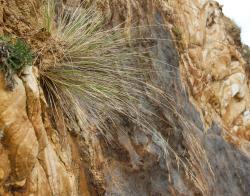- Taxon
- Gallery
- ≡ Poa caespitosa Spreng. in Biehler, Pl. Nov. Herb. Spreng. 7, no. 10 (1807) nom. illeg., non Poa caespitosa Poiret 1804
- = Poa laevis var. β filifolia Hook.f., Bot. Antarct. Voy. II. (Fl. Nov.-Zel.) Part I, 307 (1853)
- = Poa caespitosa var. leioclada Hack. in Cheeseman, Man. New Zealand Fl. 908 (1906)
- = Poa caespitosa var. planifolia Petrie, Trans. & Proc. New Zealand Inst. 47: 58 (1915)
Dense rather shining tussock, 30–100 cm, sometimes hanging down steep banks and up to 2 m, with light brownish green sometimes glaucous leaves smooth to the touch; branching intravaginal; leaf-blades persistent. Leaf-sheath pale green, later creamy brown, shining, ± membranous, smooth, or very minutely scabrid throughout, ribs inconspicuous. Ligule c. 0.5 mm, truncate, short-ciliate, abaxially minutely hairy. Leaf-blade (10)–20–60 cm ×c. 1–1.5–(2.5) mm, folded or ± flat, coriaceous, abaxially glabrous, midrib and lateral ribs not very prominent, adaxially closely minutely pubescent throughout; margins inrolled, scabrid, midnerve scabrid near acicular, often pungent tip. Culm (10)–20–50–(70) cm, ≤ leaves, internodes smooth to scabrid below panicle. Panicle (5)–10–20–(25) cm, open; branches slender, ± erect to spreading, sparsely to very closely scabrid, naked below, spikelets many on shorter secondary branchlets. Spikelets (3.5)–6–9 mm, (2)–3–5-flowered, light green to later light brown. Glumes subequal, (2)–3.5–5–(6) mm, acute to subacuminate, sparsely minutely scabrid to smooth, midnerve with sparse prickle-teeth in upper ½; lower 1–(3)-nerved, narrow-lanceolate, upper 3–(5)-nerved, elliptic-lanceolate; margins membranous with scattered fine prickle-teeth above or almost throughout. Lemma 3–5–(6) mm, 5-nerved, elliptic-oblong, obtuse, minutely scabrid, midnerve with long crinkled hairs in lower ½, scabrid above, outer lateral nerves with crinkled hairs near base; margins membranous, sparsely minutely scabrid. Palea (2)–3–4 mm, keels densely ciliate-scabrid, interkeel minutely scabrid to pubescent-scabrid, flanks short-scabrid. Callus with tuft of crinkled hairs. Rachilla c. 1 mm, scabrid or with occasional hairs. Lodicules c. 0.5 mm, occasionally hair-tipped. Anthers (1)–2–3 mm. Caryopsis c. 1 × 0.5 mm. 2n= 84. Plate 7D.
[From: Edgar and Connor (2000) Flora of New Zealand. Volume 5 (second printing).]




